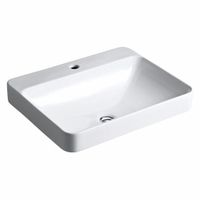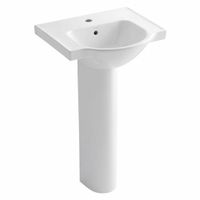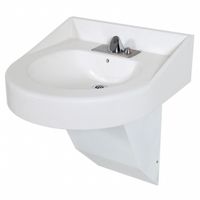Call +(254) 703 030 000 / 751 483 999 / 721 704 777
- Home
- Plumbing
- Sinks Wash Fountains Repair Parts
- Bathroom Sinks
Frequently Asked Questions
What are the different types of bathroom sink mounting styles?
1. **Drop-In Sinks**: Also known as self-rimming or top-mount sinks, these are installed by dropping them into a pre-cut hole in the countertop. The rim of the sink rests on the countertop, providing support.
2. **Undermount Sinks**: These are mounted beneath the countertop, creating a seamless look. They are ideal for solid surface countertops like granite or marble, as they allow for easy cleaning and a sleek appearance.
3. **Vessel Sinks**: These sit on top of the countertop and resemble a bowl or basin. They are often used in modern or contemporary bathroom designs and can be made from various materials, including glass, ceramic, or stone.
4. **Wall-Mounted Sinks**: Attached directly to the wall, these sinks do not require a vanity or countertop. They are ideal for small bathrooms or powder rooms, offering a minimalist look and saving space.
5. **Pedestal Sinks**: Consist of a basin supported by a pedestal or column. They are often used in traditional or vintage-style bathrooms and provide a classic look while concealing plumbing.
6. **Console Sinks**: Feature a basin supported by legs or brackets, often with a small countertop area. They combine the open feel of a pedestal sink with some of the functionality of a vanity.
7. **Integrated Sinks**: These are part of the countertop, made from the same material, providing a seamless and cohesive look. They are often found in modern or minimalist designs.
8. **Corner Sinks**: Designed to fit into a corner, these sinks are perfect for maximizing space in small bathrooms. They can be wall-mounted or pedestal style.
9. **Trough Sinks**: Long and narrow, these sinks can accommodate multiple users at once. They are often used in commercial settings but can also be a stylish choice for large family bathrooms.
How do you install an undermount bathroom sink?
1. **Gather Materials and Tools**: You will need the undermount sink, silicone sealant, plumber's putty, a wrench, a screwdriver, a drill, and mounting clips.
2. **Prepare the Countertop**: Ensure the countertop is clean and dry. If it's a new installation, the countertop should have a pre-cut hole matching the sink's dimensions.
3. **Position the Sink**: Place the sink upside down on the countertop to ensure it fits properly. Mark the positions for the mounting clips.
4. **Install Mounting Clips**: Drill holes for the mounting clips around the marked positions. Attach the clips loosely to allow for adjustments.
5. **Apply Sealant**: Apply a bead of silicone sealant around the edge of the sink opening on the underside of the countertop.
6. **Position the Sink**: Carefully lift the sink and position it under the countertop, aligning it with the opening. Ensure it is centered and properly aligned.
7. **Secure the Sink**: Tighten the mounting clips gradually, alternating sides to ensure even pressure. Do not overtighten, as this can damage the sink or countertop.
8. **Seal the Edges**: Apply a thin bead of silicone sealant around the edge where the sink meets the countertop to ensure a watertight seal.
9. **Install the Drain and Faucet**: Apply plumber's putty around the drain flange and insert it into the sink's drain hole. Secure it with a locknut from underneath. Install the faucet according to the manufacturer's instructions.
10. **Connect Plumbing**: Reconnect the plumbing, including the P-trap and water supply lines. Check for leaks by running water and tightening connections as needed.
11. **Clean Up**: Wipe away any excess sealant and clean the sink and countertop. Allow the sealant to cure as per the manufacturer's instructions before using the sink.
What is the difference between a drop-in sink and a vessel sink?
A drop-in sink, also known as a top-mount or self-rimming sink, is designed to be installed into a pre-cut hole in the countertop. The sink's rim rests on the countertop surface, providing support and creating a seamless look. This type of sink is popular for its ease of installation and compatibility with various countertop materials. The rim can be slightly raised or flush with the countertop, and it often features a lip that helps prevent water from spilling over the edge. Drop-in sinks are commonly used in kitchens and bathrooms due to their practicality and traditional appearance.
In contrast, a vessel sink sits on top of the countertop, resembling a bowl or basin. It is not recessed into the countertop but rather rests entirely above it, creating a striking and modern aesthetic. Vessel sinks are available in a wide range of materials, including glass, ceramic, stone, and metal, allowing for diverse design options. They often require a taller faucet or wall-mounted faucet to accommodate the height of the sink. Vessel sinks are typically used in bathrooms, where their artistic and sculptural qualities can be showcased.
The primary differences between the two types of sinks lie in their installation methods and visual impact. Drop-in sinks offer a more traditional and integrated look, while vessel sinks provide a contemporary and bold statement. Additionally, vessel sinks may require more careful cleaning around the base and can be more prone to splashing due to their elevated position. Ultimately, the choice between a drop-in sink and a vessel sink depends on personal style preferences, functional needs, and the overall design of the space.
How do you choose the right size bathroom sink for your space?
To choose the right size bathroom sink, first measure the available space, considering both width and depth. Ensure there's enough room for movement and other fixtures. Consider the sink's purpose: a guest bathroom might need a smaller sink, while a master bathroom could accommodate a larger one. Evaluate the sink style: pedestal sinks save space, while vanity sinks offer storage. Check plumbing locations to avoid costly relocations. Balance aesthetics with functionality, ensuring the sink complements the bathroom's design. Finally, consider user needs, such as height and accessibility, to ensure comfort and practicality.
What materials are commonly used for bathroom sinks?
Common materials used for bathroom sinks include:
1. **Ceramic/Porcelain**: These are popular due to their durability, ease of cleaning, and classic appearance. They are resistant to stains and scratches.
2. **Stainless Steel**: Known for its modern look and resistance to rust and stains, stainless steel is durable and easy to maintain, making it ideal for high-use bathrooms.
3. **Glass**: Tempered glass sinks offer a contemporary aesthetic and are available in various colors and styles. They are easy to clean but can be prone to chipping or cracking if not handled carefully.
4. **Stone**: Natural stones like marble, granite, and travertine provide a luxurious and unique look. They are durable but require regular sealing to prevent stains and damage.
5. **Cast Iron**: Coated with enamel, cast iron sinks are heavy and durable, offering a traditional look. They are resistant to chipping and scratching but can be prone to rust if the enamel is damaged.
6. **Acrylic**: Lightweight and affordable, acrylic sinks are easy to install and come in various shapes and colors. They are resistant to impact but can scratch more easily than other materials.
7. **Solid Surface**: Made from a blend of acrylic and polyester, solid surface sinks are seamless and can be integrated with countertops. They are non-porous and easy to repair if scratched.
8. **Concrete**: Customizable and durable, concrete sinks offer a modern, industrial look. They require sealing to prevent stains and are heavier than other materials.
9. **Copper**: Known for its antimicrobial properties, copper sinks develop a unique patina over time. They are durable but require regular maintenance to prevent tarnishing.
10. **Wood**: Less common, wood sinks are treated to resist water damage and offer a warm, natural look. They require careful maintenance to prevent warping and damage.
How do you maintain and clean different types of bathroom sinks?
Porcelain Sinks: Clean with a mixture of baking soda and water to form a paste. Apply it to the sink, scrub gently with a soft cloth or sponge, and rinse thoroughly. For tough stains, use a diluted vinegar solution. Avoid abrasive cleaners that can scratch the surface.
Stainless Steel Sinks: Use a mild dish soap and warm water to clean daily. For deeper cleaning, apply a paste of baking soda and water, scrub with a soft cloth, and rinse. To remove water spots, wipe with a cloth dampened with vinegar. Dry with a microfiber cloth to prevent streaks.
Glass Sinks: Clean with a non-abrasive glass cleaner or a mixture of vinegar and water. Use a soft cloth to wipe the surface, avoiding any abrasive materials that can scratch the glass. Rinse and dry with a microfiber cloth to prevent water spots.
Ceramic Sinks: Use a mild detergent and warm water for regular cleaning. For stains, apply a paste of baking soda and water, scrub gently, and rinse. Avoid harsh chemicals and abrasive pads that can damage the glaze.
Stone Sinks (e.g., granite, marble): Clean with a pH-neutral cleaner or a mixture of mild dish soap and water. Avoid acidic or abrasive cleaners that can etch the stone. Rinse thoroughly and dry with a soft cloth. Periodically seal the stone to protect against stains and moisture.
Copper Sinks: Clean with a mixture of mild soap and water. Avoid acidic or abrasive cleaners that can damage the patina. To maintain the patina, apply a thin layer of wax periodically. For a shiny finish, use a copper cleaner as needed.
Composite Sinks: Use a mild detergent and water for regular cleaning. For stains, apply a paste of baking soda and water, scrub gently, and rinse. Avoid harsh chemicals and abrasive pads that can damage the surface.
What are the pros and cons of pedestal sinks versus wall-mounted sinks?
**Pedestal Sinks:**
*Pros:*
1. **Aesthetic Appeal:** Pedestal sinks offer a classic and elegant look, suitable for traditional and vintage-style bathrooms.
2. **Space Efficiency:** They are ideal for small bathrooms as they take up minimal floor space.
3. **Easy Installation:** Generally easier to install than wall-mounted sinks, as they do not require reinforced walls.
4. **Concealed Plumbing:** The pedestal base hides plumbing, providing a cleaner appearance.
*Cons:*
1. **Limited Storage:** Lack of countertop and under-sink storage can be inconvenient.
2. **Cleaning Challenges:** The area between the pedestal and the wall can be difficult to clean.
3. **Less Stability:** Can be less stable than wall-mounted sinks if not properly installed.
**Wall-Mounted Sinks:**
*Pros:*
1. **Modern Look:** Offers a sleek, contemporary appearance, ideal for modern bathrooms.
2. **Floor Space:** Frees up floor space, making the bathroom appear larger and easier to clean.
3. **Customizable Height:** Can be installed at any height, accommodating different user needs.
4. **Versatile Design:** Available in various styles and sizes, offering more design flexibility.
*Cons:*
1. **Complex Installation:** Requires reinforced walls and professional installation, increasing costs.
2. **Exposed Plumbing:** Plumbing is often visible, which may not suit all design preferences.
3. **Weight Limitations:** May not support heavy sinks or excessive weight, limiting material choices.
4. **Maintenance:** Wall-mounted sinks can be more challenging to maintain if plumbing issues arise.


